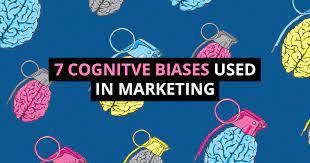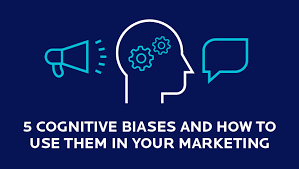We remain basic, genuine human beings with our stories, experiences, feelings, responses, preferences, and prejudices, in spite of the fact that contemporary technology has become an inseparable part of our life and an all-encompassing digital world has become our new reality.
We believe it’s important to look at a variety of applicable psychological theories, better known as cognitive biases in this context, because content is an important way to connect with your target audience in digital marketing, and psychology is the basic science that studies the human mind and thus the behavior of this target audience. These considerations will assist you in better understanding the influence your content may have on your consumers and will be beneficial when developing a successful content marketing plan for your company.
What are cognitive biases and how can you avoid them?
Cognitive biases are mental shortcuts that help us grasp reality.
Our brains process 20,000 bits of data each second, yet we’re only aware of seven of them at any one moment.
We may make quick assumptions and draw conclusions thanks to cognitive biases since we don’t have to think too hard. We are on autopilot for 99 percent of the time.
Psychologists and experts from many fields have discovered cognitive biases, and each one affects our decision-making in a different way. Using the psychological approaches mentioned in this article, you may create more convincing marketing communications and have a greater effect on the purchasing choices your target audiences make.
Understanding and, ideally, overcoming fundamental human cognitive or psychological biases that commonly lead to poor judgements and financial miscalculations, we believe, is critical to being a successful long-term investor (Venture Capitalist). Due to cognitive biases, we are all prone to taking shortcuts, oversimplifying hard topics, and being overconfident in our decision-making processes. Understanding our cognitive biases may help us make better judgments, which is crucial for lowering risk and enhancing long-term investment returns, in our view.
Learn about 10 cognitive biases that influence your customers’ decisions.
1) The Effect of Uncertainty
Assume you have two choices for lunch. You may go somewhere familiar and enjoyable, even if it isn’t your favorite, or you could go somewhere completely unexpected. This second restaurant may be great or disastrous.
Which would you choose? If you’re like most people, you’d choose the first option rather than risk a tense midday meal.
Due to the ambiguity effect, people reject choices with unknown or untested consequences. You may now tell your friends that there’s a scientific reason why it’s so tough to leave your favorite restaurant.
Takeaway for sales: Make sure clients understand the potential results of using your product, and answer quickly to any questions or knowledge gaps they may have.
In the last year, the way investors pick where to put their money has changed dramatically in venture capital.

2) The Opposite Effect
When you’re speaking with someone who has a strong opinion, facts that directly contradict that opinion will not persuade them to change their views.
In fact, the backfire effect will reinforce their conviction that they are right. Debating the truth of your comment draws them closer to the side they already favor.
Takeaway for salespeople: If a prospect has a mistaken belief, don’t approach them with contradicting data. Rather, enquire about their motivations. They’ll figure out their own weaknesses in thinking.
3. Effect of Anchoring
It is often said that one should not judge a book by its cover. Unfortunately, our minds are hardwired to do just that.
The initial piece of information we learn about a person or circumstance shapes our entire perspective, whether for good or poor. Why? The first detail serves as an anchor against which all subsequent information is contrasted and assessed.
Takeaway for salespeople: First impressions are crucial. Prepare a strategy for introducing yourself and your goods. Make sure the buyer’s initial impressions of your offering are pleasant and establish a high bar for the remainder of the purchase process.
Venture Capitalists are suddenly becoming more cautious with cash, much to the consternation of startups.
4) Discounting via hyperbola
You can witness hyperbolic discounting in action if you give a kid a candy bar today and two tomorrow. Now is always preferable than later. You’ll most likely not even complete your statement before they grab the goodie and devour it.
Adults, it turns out, are still influenced by this phenomenon. Our minds are naturally driven to incentives that are immediate rather than those that are long-term. Hyperbolic discounting’s “discounting” portion refers to the fact that the perceived value of a reward lowers as time passes.
Sales takeaway: Highlight the immediate benefits a consumer may anticipate to notice after purchasing your product or service, particularly if the primary advantage won’t arrive for months.
5) The Adoption Effect
Beanie Babies are stuffed animals. Rocks for pets Dolls of trolls. These toy crazes now appear a little goofy. But did you purchase one or already own one? “Everyone else was doing it…”, to be sure.
There’s no need to be embarrassed; there’s a reason you joined the trend. People are naturally drawn to items or services that they see others utilizing. The psychological attraction becomes stronger as the gathering becomes bigger.
Takeaway for sales: Social proof is more important than you may realize. Showcase your company’s customer base and introduce prospects to existing clients.
The venture capitalist sector is always changing, but some of the most significant shifts have occurred in the previous two years.

6) Decoy effect
Do you find it difficult to choose between two options? Perhaps adding a third will be beneficial.
Huh? Exactly my thoughts. Although unreasonable, the decoy effect has been empirically established.
In a Duke University study, participants were given two meal options: a five-star restaurant that was far away or a three-star venue that was close by. The diners were split in two. However, after a third alternative was introduced— a four-star restaurant even farther away than the five-star— it became much easier to chose the five-star option. It had the finest quality and was just somewhat worse than the third option.
Takeaway: When providing numerous variations of a proposal or contract, use alternatives to your advantage. Introduce a decoy to reinforce the prospect’s inherent propensity if they are having trouble deciding.
7) The Effect of Rhyme as an Explanation
“If it doesn’t fit, you must acquit.” During O.J. Simpson’s famous 1994 murder trial, Johnnie Cochran used this simple couplet to center his defense of the former football star to the jury.
Cochran may have taken advantage of the rhyme-as-reason bias since rhymes are easier to remember. Because of this psychological quirk, rhyming remarks are seen as more honest than non-rhyming words with the same meaning. As you now know, being a poet pays nicely.
Make a catchy rhyme out of your value proposition or a noteworthy takeaway about your product for your sales takeaway. This method might likewise be used to a problematic or perplexing aspect of your service.
Due to overvaluation, a flood of “unicorns” are taking longer and longer to go public. This means that Venture Capitalists will have to wait longer for their money to be repaid.
8) IKEA’s Influence
There’s no escape the apparent confusion while reading assembly instructions from a Swedish furniture retailer, but that’s not the purpose of this article.
The IKEA effect, on the other hand, refers to the fact that people value items they helped create more than products manufactured by others that are similar — or even better. While this effect may be harmful to creators (ownership of the concept may cause them to be blind to issues), it may be useful to salespeople.
Takeaway for salespeople: Let customers help you customize or personalize your product or service. They will be more enthused if they feel that the giving is “theirs.”
9) The Curse of Knowledge
The curse of knowledge happens when your better knowledge prevents you from empathizing with the problems of an uninformed person.
Salespeople who are confident in the capacity of their product to benefit a prospect may fall to this prejudice by dismissing the prospect’s arguments. Instead of listening to these concerns and taking the time to clarify areas of misunderstanding, representatives resort to saying, “But it works!” “Don’t believe me!”
Takeaway: Instead of arguing that your product answers your prospect’s issue, act as a trusted advisor. Strong reasoning, customer reviews, and testimonials may help reps overcome fears, but education is the key.
Your prospects don’t understand the value of your offer if they continue to raise inquiries disguised as objections. They are only interested in how the product will work for them, not if it works.
A Venture Capitalist must take a long and often grueling route to sign a term sheet and/or have the opportunity to invest in a company.
10) Overconfidence
We’ve been socialized to believe that the future will be better than the present.
The optimism bias may either benefit or hurt salespeople. On one side, aiding prospects in anticipating a better future may be advantageous. Prospects, on the other hand, are often too optimistic; even when they are now in pain, they may believe that the situation will resolve itself (or at least stay the same).
Salespeople should offer two scenarios: life with and life without their goods to guarantee that buyers are enthused about the right things. Prospects will benefit from this mental practice in combating illogical notions.
Prospects’ expectations about when they will see results must also be moderated by reps. Some things take months or even years to pay for themselves, leaving buyers disappointed and disappointed if they expected quick results.
Prospects may also expect the hard work to begin when the transaction is done. For things with complex or lengthy implementations, however, considerably more has to be done. Salespeople may avoid buyers wearing blinders by explaining what will happen after the agreement is signed in a clear and concise manner.
Don’t get me wrong: I think being a venture capitalist is a terrific job (you get to do anything you want…), but I believe that entrepreneurs would benefit from understanding what goes on behind the scenes.
Be fearless.
Consumers aren’t converted by accident; great marketing campaigns use a clear message to guide buyers through the decision-making process. It’s not about duping or misleading them into buying anything. It all comes down to understanding how people think and presenting your company in the most effective way possible, which is getting more difficult in the highly competitive online economy.
The cognitive biases we highlighted today aren’t the only ways to boost conversion and income. You may also use them to enhance user experiences, retain customers, and ensure that they keep doing business with you.

